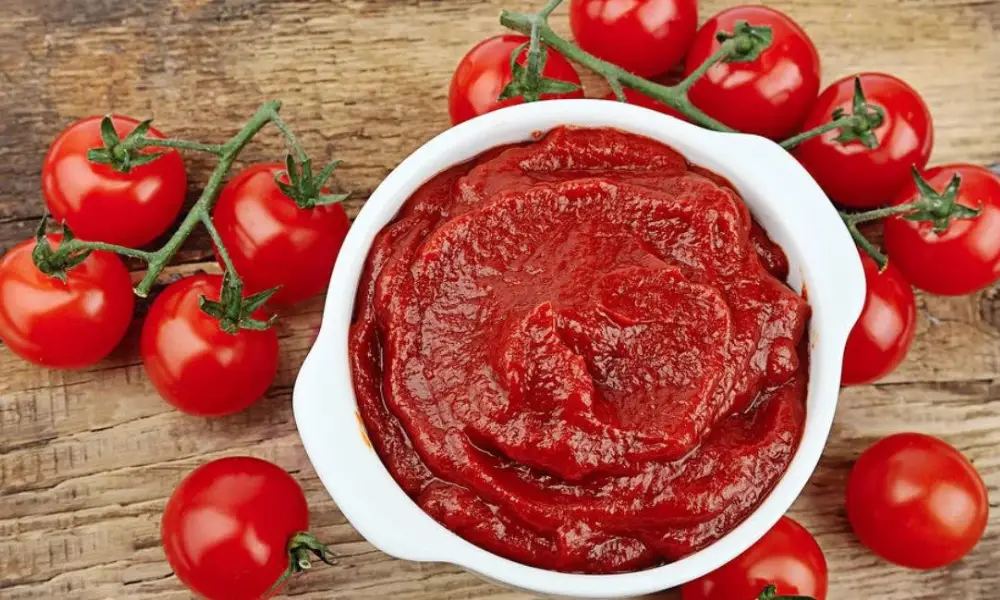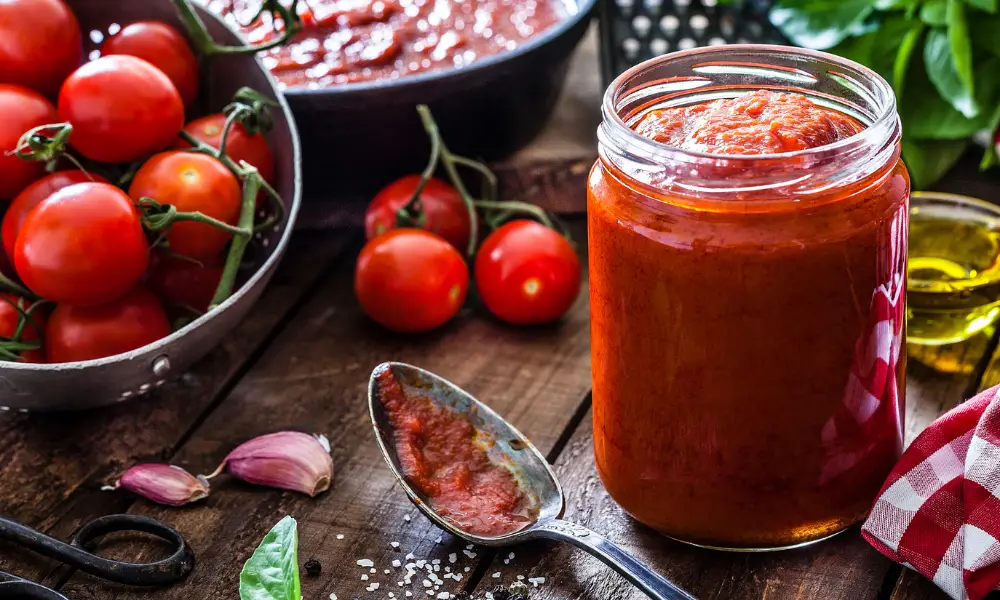Have you ever questioned whether or not tomato paste should be kept in the refrigerator? Cooking with tomato paste is a fantastic method to give food taste and colour. Additionally, it can be used as a base for soups, stews, pasta, sauces, and more. But how long does it last once it’s been opened, and does it eventually spoil?
You are in the right spot since this article will show you how to properly store tomato paste, both handmade and purchased from a store (and get the most out of it too).

Tomato Paste: What is it?
Tomato paste is a condensed kind of tomato sauce or dominates salçasi, as we say in Turkish. Tomatoes are pureed and simmered for a very long time until they almost entirely decrease. Removing the skin and seeds from tomatoes is simple, and the sauce is baked or dried in the sun until the desired thickness is achieved.
Considering the entire process described above, we can say that tomato paste goes far beyond simple tomato sauce. It is thick, to start with. Depending on the meal you’re cooking, you might even need to thin it out with water. Furthermore, it has a considerably richer flavor than tomato sauce.
How Long does Tomato Paste Last in the Fridge?
If maintained correctly in an airtight container or the factory-sealed tube packing, tomato paste can be kept in the refrigerator for seven to ten days. But tubed tomato paste can stay in the fridge for up to a month.
To retain its flavor and shelf life, the paste should be refrigerated after opening, whether in a can, a glass jar, or a tube.
The tomato can be kept in the refrigerator for up to 10 days after being removed from the can and placed in an airtight portioned container.
This also applies to paste in a tube or glass jar, although it is not required to be placed in a container. It can be stored in its original container, directly in the refrigerator.
Unused Tomato Paste
Despite being one of the most widely used ingredients in almost all cuisines worldwide, a lot of tomato paste is wasted because people don’t know how to store it properly and don’t often use the entire can for a meal, which leads to it going wrong and becoming moldy. If properly maintained, a can of tomato paste will usually retain its optimum quality for 18 to 24 months, after which it will likely still be safe to use.
The tube is always preferred when buying tomato paste unless you’re making considerable quantities of food that call for the entire can. Tomato paste in boxes can be stored in the refrigerator for 6 to 8 weeks after opening. Once opened, tomato paste in a can only remain edible for 5-7 days.
Opened Tomato Paste
Tomato sauce, an affordable, versatile, and savory pantry staple, gives your recipes depth of flavor and complexity. Tomato sauces for pizza, spaghetti, chili, and other foods can be easily made with it. It can also enhance the flavor of soups, stews, and braised meat because of its potent umami flavor, especially when caramelized.
Storage conditions considerably impact the precise response; keep opened tomato paste excellent and tightly packed. To increase shelf life and decrease food waste, the store opened tomato paste in the refrigerator in a covered glass or plastic container.
Using Tomato Puree or Tomato Paste? What is the Distinction?
Fresh tomato sauce, such as passata that has been strained or processed in a food processor to remove the seeds and skins, is referred to as tomato puree. On the other hand, tomato paste is a concentrated purée made from ripe tomato skin and flesh. It is created by reducing tomatoes to a simple, thick purée, straining them, then boiling them once more to almost completely remove the moisture.
The typical packaging for store-bought tomato paste is cylindrical cans or tubes. Additionally, it may be referred to as double or concentrated tomatoes.
What is the Flavor of Tomatoes?
The puréed fruit and peel produce a highly potent and robust aroma and flavor because of their rich and concentrated flavor.
It’s simple to find tomato paste and puree in supermarket stores. Even though you can swap one out for the other when cooking, they are still two distinct entities.
Now that you know what tomato paste and puree are let’s move on to the main objective of this essay.
Homemade Vs. Purchased Tomato Paste
Although it is debated which is better, most people concur that homemade is preferable to store-bought. I like the more practical and long-lasting canned or tube paste that can be purchased in stores.
However, there will always be extra food because, except for Jollof rice, nearly no recipes call for the entire can or tube of tomato paste. So, the topic of how to preserve something to increase its shelf life is always present.
Can Tomato Paste be Frozen?
If you want to keep tomato paste around for longer, you can freeze it. If you purchased a can of tomato paste and have leftovers that you don’t intend to use within the next five days, this is a fantastic approach to reduce food waste. The most significant disadvantage is that defrosted tomato paste degrades, and separating the two is challenging because prepared foods frequently use tomato paste.
Halfway up the ice cube trays, add the paste. The amount of frozen tomato paste required for your food preparations should be defrosted, not the entire container. Take the firm tomato paste in a bag and transfer it from the ice cube trays to the freezer. Take one scoop out whenever you need to use tomato paste and defrost it in the saucepan on low heat before you start cooking.
It can also be frozen overnight after being wrapped in plastic. Use the metal end to push the paste out of the open end the next day. Repackage the item after removing it from the can. You can remove one as necessary for each meal.
When kept in a freezer, canned tomato paste keeps its optimum quality for around four months; however, it can be consumed much longer.
How to Identify A Rotten Tomato Paste?
Since tomato paste is naturally moist, it most likely becomes a breeding ground for mold once it has gone wrong.
The moldy surface of tomato paste, which might be greenish or yellowish, should be thrown out immediately.
Additionally, spoiled tomato paste will emit an odor of solid and sour, with no authentic tomato flavor. At all costs, you shouldn’t attempt to salvage it.
Generally speaking, if you think anything has been sitting in the refrigerator for too long, it should be thrown out.
How to Keep Tomato Paste Fresh?
Methods for Storing Extra Tomato Paste
There are a few methods for preserving leftover tomato paste. If you plan to use the remaining paste within a week of opening the can, you can look in the refrigerator, or if you don’t currently have any other plans, you can look in the freezer. In either case, the tomato paste must be carefully preserved to be safe.
Option for the refrigerator: Place any remaining tomato paste in an airtight container and place it there. Use the tiniest container you can—even a baggie—to ensure that it has the fewest air bubbles. Never keep it in the can as a storage solution.
Options for the freezer:
Use an Old Ice Cube Tray
Fill an ice cube tray with the leftover tomato paste, then freeze it. After being frozen, place the cubes in an airtight freezer container with a label for use within three months.
Make Use of a Baking Sheet
- Drop level tablespoons of the paste spaced an inch apart on a rimmed baking sheet lined with wax paper.
- Ten level teaspoons of tomato paste are contained in a six-ounce can.
- The tomato paste blobs should be frozen until solid before being placed in a freezer-safe bag for storing.
- The paste is pre-measured and ready to use, so measuring it is unnecessary.
Can-less Option
If you frequently use a tiny amount of tomato paste, think about buying it in tubes rather than cans. After squeezing out the required amount, a line can be opened and kept in the refrigerator for approximately six weeks. When you open the tube, write the date on it with a permanent marker. This approach is slightly more expensive up front, but it can wind up saving you money if your leftover tomato paste starts to mildew in the fridge.
I lost count of how many times I used to discover a little, nearly unidentifiable container in the back of the refrigerator that I eventually deduced must have been tomato paste.
How to Make Tomato Paste at Home?
Ingredients To make homemade tomato paste, we only need two essential components.
Tomatoes: Because they are juicy and contain fewer seeds, Roma or plum tomatoes are the best. You have a sizable volume of paste in the end. On the other hand, because they are not as meaty, you need less tomato paste if you want to utilize fancy-looking heritage tomatoes. Additionally, they need more time in the oven to evaporate their juice. If you use heritage tomatoes, the color won’t be as red. That said, the flavor would be just as delicious. So, any tomato can be used to make tomato paste, but keep the information mentioned above in mind.
When preparing tomato paste, salt is mainly used as a preservative rather than for flavor. So salt quality is essential. The most pleasing possibilities are sea salt and kosher salt, but be sure they are pure and devoid of additives. NEVER use table salt in your homemade tomato paste, just like when bringing green olives. Table salt won’t serve as a preservative because it has additives.
What to do:
Four simple stages make up this recipe for tomato paste:
- Prepare the tomatoes first. You only have to cut them in half or fourths, making sure to remove the stems. Batch-purée them in a food processor after adding the ingredients. After that, add kosher salt to the purée and transfer it to a big pot.
- Cook it on the stove second. Uncovered, cook it over medium-high heat until the tomatoes start to boil and release juice. Boil continuously for 30 minutes. This will aid in the extra water evaporating. You will see foams on top in the meantime; use a spoon to remove them. After that, turn down the heat to medium-low and simmer the puree for about 40 minutes, or until it reaches the desired consistency. Await cooling
- Third, use a filter to get rid of the skin and seeds. Put a sieve over a big bowl and do this. In the sieve, pour the tomato sauce. Use a spoon to press down the sauce until the seeds and skin are all left in the filter. Refill the pot with the sauce. Then, place the saucepan back over medium heat and simmer for 40–50 minutes, or until it thickens.
- Finally, spread the sauce thinly across one or two baking pans to dry it in the sun. Depending on the weather, please leave it in the sun for 3 to 4 days until it becomes very thick. The tomato paste can be put into jars after this time has passed.
Conclusion
You may wonder: How long does tomato paste last in the fridge? The latter two varieties keep for six to eight weeks. But if you’re buying paste for a large group of people, a bottle or tube will do just fine. In addition to making your meals taste better, they also extend the life of tomatoes. In addition to being valid for large groups, tomato paste will enhance the flavor of spaghetti, stews, soups, and fried chicken.
